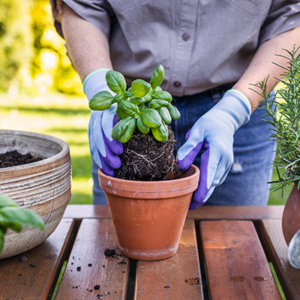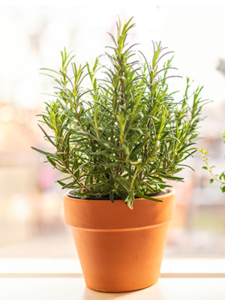Now that winter’s in full swing, you’re probably missing all the greenery that once covered your yard. And while the holiday lights provide some cheer, nothing can beat the look of vibrant green grass and gardens. By starting an indoor herb garden, you can bring some of that greenery indoors, where you’ll enjoy it all year long. Plus, all these herbs smell and taste amazing! Here are just a few of the easiest herbs to grow indoors.
Take Your Gardening Indoors With These Lovely Herbs
1. Basil
One of the most fragrant of herbs, basil is great in many foods. Like most of the plants on this list, you’ll want to provide it with a south-facing window, if possible, so that it can enjoy the most sun. If there aren’t southern windows available, east is a good alternative. Avoid north-facing windows at all costs. Unfortunately, in the northern hemisphere, these receive the least amount of sunlight. Basil likes to be warm, which makes it a great choice for growing inside. Keep basil well-watered, but also make sure the plant has drainage as it likes moist but not soggy soil. Also, don’t water the leaves – water the soil directly. When it’s ready to harvest, prune about 20% of the plant at maximum at any one time. This will allow you to enjoy continual harvesting without stressing the plant. Throw your basil in fresh homemade pesto or atop a pizza!
2. Chives
Keep your chives in a sunny place. You’ll only need to place the seeds about 1/4 beneath the soil and space them out in the container. Water thoroughly after first planting, and keep the soil moist. These are tiny onions, after all, and they need lots of moisture. That being said, they do have some drought tolerance once established. You should expect to see chives sprout in 10 – 15 days. When you’re ready to harvest, use kitchen scissors to trim one or two inches from the tips.
3. Oregano
The neat thing about oregano is that it’s one of those herbs you can propagate from a clipping! If you don’t feel like starting from seed, pick up a bundle of fresh oregano the next time you go grocery shopping. Plant a leaf tip with a bit of stem on it, and voila! Like chives, oregano doesn’t require a lot of watering, so don’t water again until the soil feels dry to the touch. There are several varieties of oregano to choose from. Depending on what your favorite type of cuisine is, one type may seem more desirable than others.
- Common oregano has a sweeter taste and is used in traditional English and French cooking.
- Golden oregano produces a milder flavor for those that want the health benefits but not the full flavor of this herb.
- Greek oregano is a favorite in Mediterranean dishes and what you probably think of when you picture oregano.
- Mexican oregano is dried and used in chili powders, so if you’ve ever wanted to try your hand at crafting your own chili mix, this might be the one for you.
4. Parsley
Like oregano, parsley can be propagated from a clipping of a fresh bunch – if you don’t want to wait several weeks for seeds to germinate. Though it prefers full sun, it can make do with an east or west-facing window, though it may not grow as quickly. Like chives, you’ll want to plant the seeds just beneath the surface of the soil. Wait until the plant is at least six inches tall before you begin to clip from it and start with the lowest, outermost leaves.
5. Thyme
Like parsley, thyme can get by with an east or western window if a southern window isn’t an option. Thyme actually prefers more arid climates, like its native Mediterranean, so if possible, keep it out of the kitchen where it will be exposed to excess moisture from cooking. When it comes to watering, thyme is the least fussy of all the herbs we’ve discussed. In fact, it’s quite drought resistant, so if you’re one of those gardeners who have trouble remembering to water your crops, thyme is quite forgiving.
FAQs
-
Q: What is the best location for growing herbs indoors in Pensacola, Florida?
A: The best location for growing herbs indoors is near a south-facing window to maximize sunlight. If this isn’t available, east or west-facing windows are suitable alternatives. Consider using grow lights if natural light is limited15. -
Q: How often should I water my indoor herbs?
A: Water your herbs when the top inch of soil feels dry to the touch. Avoid overwatering, as this can lead to root rot. Ensure your containers have good drainage holes25. -
Q: What type of soil is best for indoor herbs?
A: Use a well-draining potting mix specifically designed for containers. For herbs like rosemary and thyme, a mix of cactus and regular potting soil works well35. -
Q: Can I grow herbs from cuttings or seeds indoors?
A: Yes, many herbs can be grown from cuttings or seeds indoors. Basil, mint, and rosemary are easy to start from cuttings, while basil, parsley, and cilantro are simple to grow from seeds34. -
Q: How do I prevent pests in my indoor herb garden?
A: Use cultural and mechanical methods to control pests. For example, use yellow sticky traps for fungus gnats and trim off infested branches for aphids. Soft insecticides like neem oil can be used in extreme cases2. -
Q: How often should I fertilize my indoor herbs?
A: Fertilize your herbs with a low dose of water-soluble fertilizer every 2 to 4 weeks. Avoid over-fertilizing, as this can affect the herb’s aroma and taste25. -
Q: What are some common signs of overwatering in indoor herbs?
A: Common signs include yellowing leaves, droopy plants, and root rot. If you notice these symptoms, reduce watering and ensure your containers have proper drainage
Trust The Experts At Turf Pro Plus
Whether you already have an outdoor herb garden, vegetable patch, or flower beds, when it’s time to take the gardening outdoors once again, we can help. For nearly a decade, Turf Pro Plus has provided lawn care services to homes in Pensacola and throughout Florida. Our weed control program targets annoying plants both before and after they germinate, so your garden remains weed-free all season long. To learn more or schedule a treatment, give us a ring at 513-545-6295, or you can tell us about your yard’s needs through our online form here.
Liked this blog? Browse previously published blogs on our blog page here.
See photos of our work and stay up-to-date on the latest deals by liking our Facebook page.